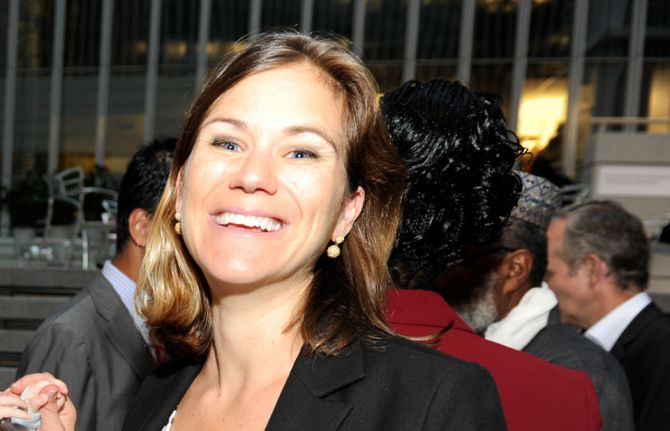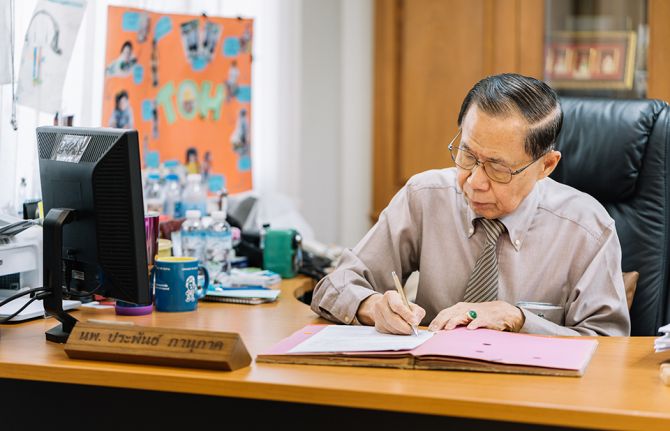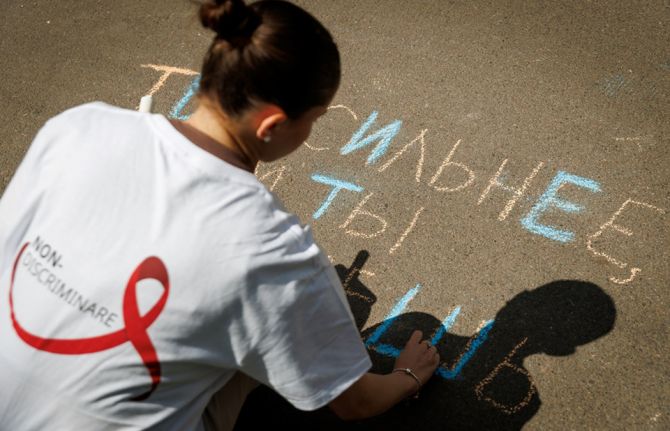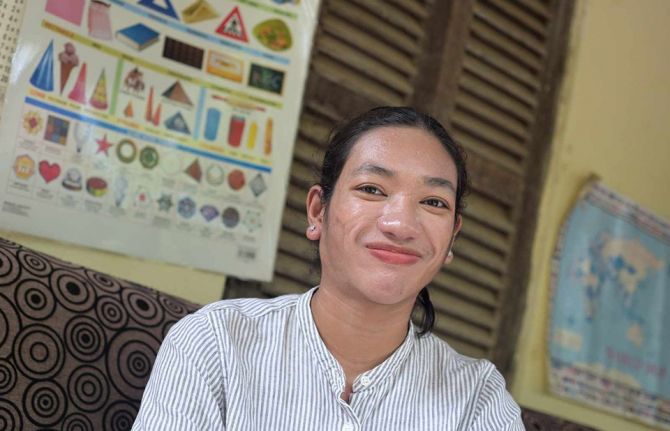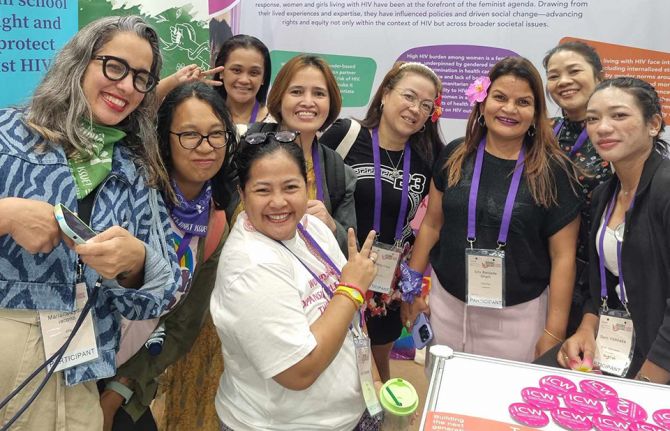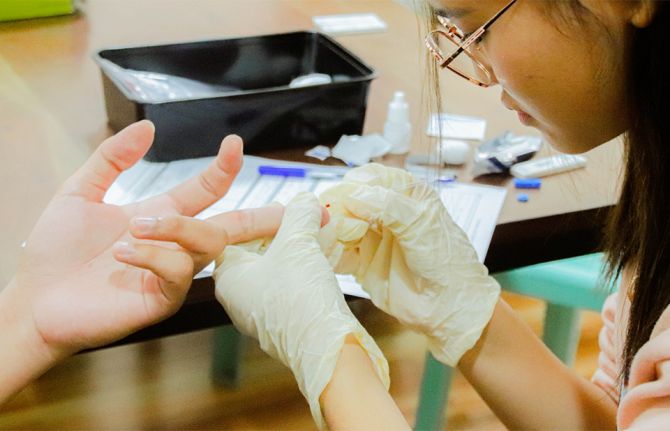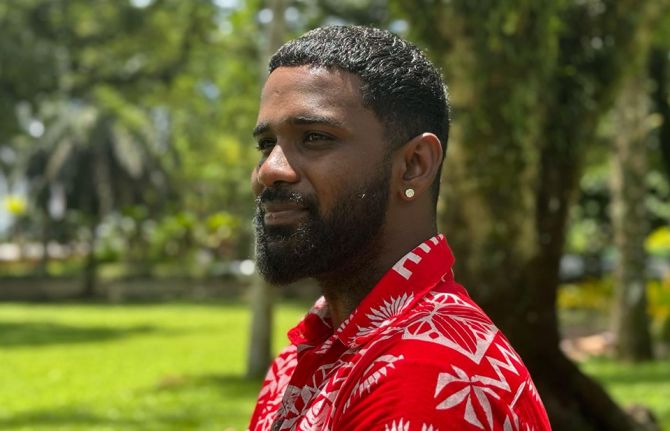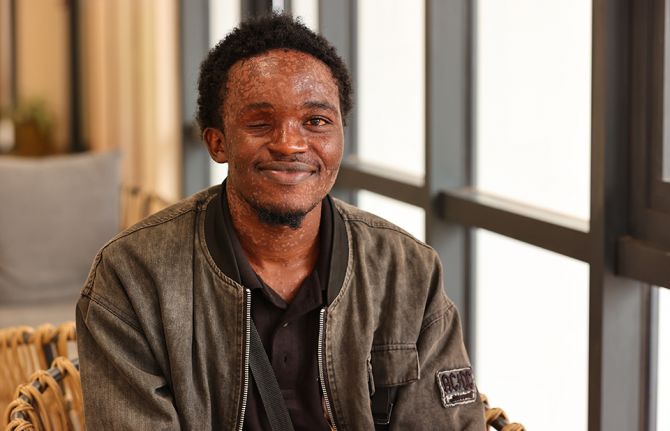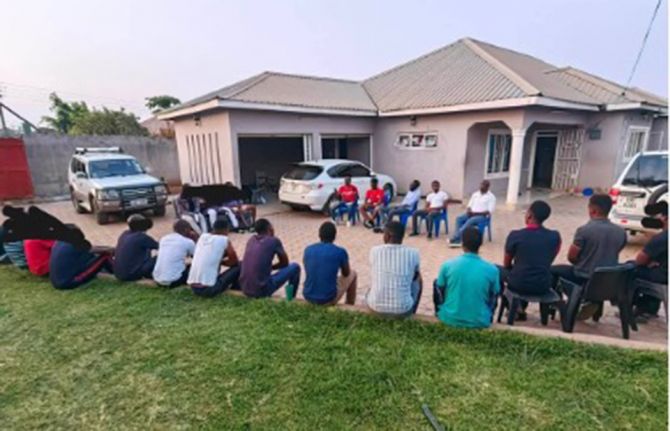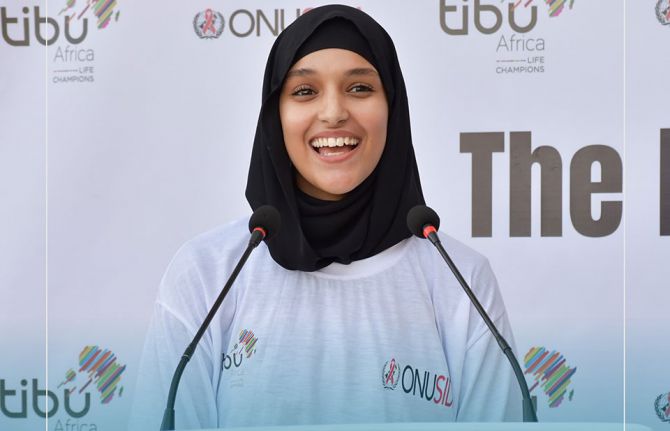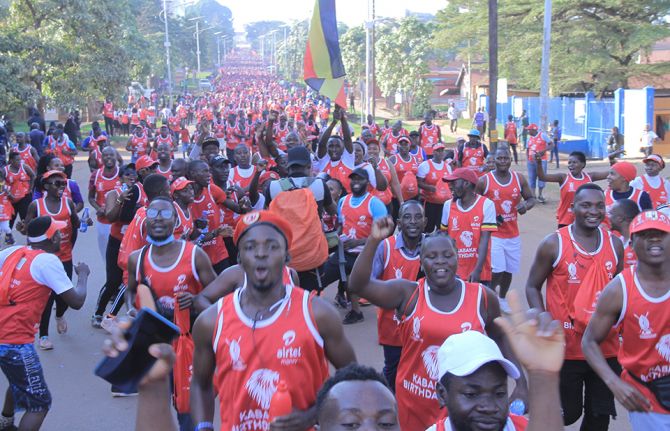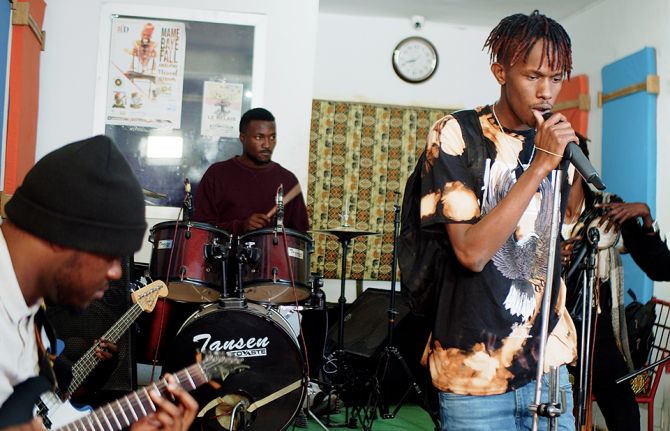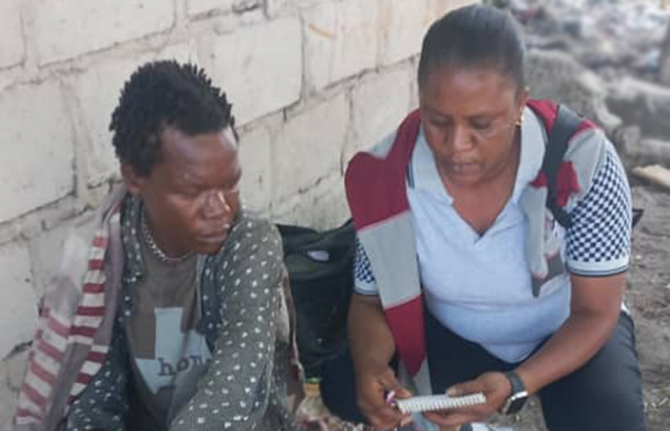
Feature Story
CONDOMIZE! Campaign hits AIDS 2012
24 July 2012
24 July 2012 24 July 2012
The CONDOMIZE! Campaign seeks to raise awareness about the importance of condom use in a lively and engaging way.
Credit: Scott Henderson
There is a renewed emphasis on condoms at the XIX International AIDS Conference being held in Washington, DC from 22-27 July as a campaign promoting their use and availability has been re-launched with the distribution of 850 000 condoms.
The CONDOMIZE! Campaign aims to highlight the effectiveness of condoms, male and female, for HIV prevention and calls on governments, donors and users to intensify access to, and demand for, quality condoms as a primary defence against HIV. It advocates investing significant resources and materials into promoting condom use as the most efficient and available prevention technology in the global AIDS response. Challenging the stigma that still often surrounds condoms is also a key objective.
“Let us not forget that the condom remains the cheapest and highly effective method we have to stop the spread of HIV,” said UNAIDS Executive Director Michel Sidibé championing the importance of condoms during his opening speech at the conference. “It is time for all of us to condomize!,” he added.
The initiative was born during the 2010 International AIDS Conference in Vienna and is a partnership between UNFPA and The Condom Project, in close collaboration with Bahamas Red Cross; DKT International, a social marketing NGO; Durex, the Female Health Company, the International AIDS Society and UNAIDS.
In addition to mass condom distribution, rap music with short videos has been created, using key messages from senior international leaders about the importance of condom use. These messages are being shown on TV screens throughout the conference.
Franck DeRose, Executive Director of the Condom Project and Global Coordinator of the CONDOMIZE! Campaign, says “In a modern and exciting way, we are helping people understand very serious issues and the need to promote condom use. We must ensure that those who need condoms can access them when they need them and where they feel most comfortable. The awareness campaign at AIDS 2012 is one step towards making this happen.”
Let us not forget that the condom remains the cheapest and most effective weapon we have to stop the spread of HIV. It is time for all of us to condomize!
UNAIDS Executive Director Michel Sidibé
The campaign noted that there is a considerable shortfall in condom availability in a number of countries. For example, in 2011 in sub-Saharan Africa there were only nine condoms available per man per year and only one female condom for every 10 women. These condoms were mostly provided by donors as most low- and middle-income countries do not have a budget line for condom procurement.
According to UNFPA more support and funding are needed from governments themselves to increase the availability of male and female condoms. They should create awareness initiatives and encourage people to use condoms as an important facet of a combination HIV prevention approach which uses all proven methods of avoiding infection.
“We know that sexual transmission accounts for more than 80% of new HIV infections worldwide – if we increase protected sex, we could reduce HIV incidence,” said Bidia Deperthes, UNFPA’s Senior HIV Technical Advisor.
The social marketing of these commodities is highlighted by the involvement of DKT International whose President Philip Harvey says he wants to make condoms as “attractive and convenient to buy as Coca-Cola”. Condoms manufacturer Durex welcomes the chance to be involved in such an awareness-raising intervention. Charles Shepherd, the company’s Head of Health Promotion comments: “We are delighted to help, not only by donating half a million condoms for the CONDOMIZE! programme at AIDS 2012, but also engaging with the educational sessions.”
Organisers say there has already been a great deal of interest shown with many conference participants urging them to roll out the campaign at country level.
External links
Related

Feature Story
Sex workers demand respect for their fundamental rights in a parallel summit to the AIDS 2012
25 July 2012
25 July 2012 25 July 2012
Sex worker initiative Veshya Anyay Mukti Parishad (VAMP) give a performance at the opening of the Sex Workers’ Freedom Festival in Kolkata, India.
Credit : UNFPA/J.Cabassi
As thousands of delegates gather for the XIX International AIDS Conference (AIDS 2012) in Washington, D.C. this week, a parallel satellite hub, the Sex Worker Freedom Festival, is taking place in Kolkata, India, from 22-26 July.
The event brings together over 600 sex workers, international and national partners from more than 40 countries. The Freedom Festival has been organized by sex workers as a response to extensive visa regulations for sex workers and people who use drugs, which may have prevented many from attending the International AIDS Conference event in Washington DC. The five-day festival gives participants the opportunity to be part of the Washington event through video-conferencing link up with major conference sessions and with the Global Village.
“The Sex Worker Freedom Festival is an alternative event for sex workers and our allies to protest our exclusion and ensure the voices of those excluded are heard in Washington.” said Ruth Morgan the Global Coordinator of the Global Network of Sex Work Projects (NSWP) and Co-Organizer of the Kolkata event.
Speaking at the opening of the Kolkata hub, United Nations Secretary General’s Special Envoy on AIDS in Asia and the Pacific, Prasada Rao, stressed that freedoms and rights of sex workers are being denied on a daily basis.
“Aspects of sex work are criminalized in 116 countries around the world. Laws in many countries conflate adult consensual sex work with human trafficking. Routine police raids, often in the name of anti-trafficking, lead to arrest and harassment of adult consenting sex workers,” said Mr Rao. “These discriminatory practices drive sex workers to social exclusion and into a socially disadvantageous position, accentuating their vulnerability to HIV,” he added.
Despite progress made in reducing the spread of HIV within sex work communities, sex workers are still at increased risk of HIV infection. In the Asia-Pacific region for example, while a number of countries have reduced their HIV infection rates with intensive HIV prevention programmes among people who buy and sell sex, hotspots of high prevalence remain. Surveys of female sex workers in India show prevalence of 18% in Maharashtra and 41% in Pune—the overall adult level in the country is an estimated 0.3%.
Sharing experiences, driving progress
The Sex Worker Freedom Festival programme is structured around fundamental freedoms; human rights that all people are entitled to. These include freedom of movement; freedom to access quality health services; freedom to work and choose occupation; freedom to unionise; freedom to be protected by the law; freedom from violence; and freedom from stigma and discrimination.The Festival aims to facilitate the sharing of experiences as well as dialogue around key issues and priorities for the sex work community and HIV programming.
“Without the right to organize and unionize the sex worker community cannot advance our rights,” stated Bharati Dey, General Secretary, Durbar Mahila Samanwaya Committee (DMSC), co-organizer of the Kolkata Hub.
Discriminatory practices drive sex workers to social exclusion and into a socially disadvantageous position. This accentuates vulnerability to HIV
United Nations Secretary General’s Special Envoy on AIDS in Asia and the Pacific, Prasada Rao
The stigma and discrimination experienced by sex workers was identified as a major obstacle to an effective response to AIDS. “Every day and in every location, we have to battle against stigma and discrimination,” said Lakshmi, a sex worker and the Director of Programmes at the Ashodaya sex worker initiative in Mysore, India, said. “We have found a way to be part of the solution. Our team of HIV positive sex worker volunteers has built an effective partnership between communities and health services. This has changed attitudes of health care providers and has created community confidence to access health services.”
Annah Pickering, a sex worker and Manager of the Auckland Region, New Zealand Prostitutes Collective, underlined the multiple benefits of decriminalization of sex work in her country, both for sex worker rights and the HIV response. “We appreciate many legal freedoms. We can report corrupt officials who demand free sex. We don’t hide our condoms in our bras or behind the picture or in the thermos flask. We can put up signs and promote safe sex and insist on it. Does decriminalising sex work prevent the transmission of HIV? I strongly believe so. When you put all these elements together they contribute significantly to support sex workers in preventing the transmission of HIV,” she said.
A central theme of discussions at the Kolkata Hub has been the widespread experiences of violence faced by sex workers around the globe on a daily basis. Sessions have underlined how documentation of sex workers’ experience of violence is critical to ensuring evidence is used to inform effective responses. A sex worker led research project being conducted in Sri Lanka, Myanmar, Nepal and Indonesia by the Center for Advocacy on Stigma and Marginalization (CASAM), the Asia Pacific Network of Sex Workers (APNSW), UNFPA, UNDP, UNAIDS and Partners for Prevention was highlighted as an important initiative in better identifying the risks and factors that help protect sex workers’ from violence.

UN Secretary General’s Special Envoy for AIDS in Asia and the Pacific Mr Prasada Rao speaks at the opening of the Sex Workers’ Freedom Festival in Kolkata, India.
Credit: UNAIDS
“This research is designed to generate quality data, that ensures sex workers’ lived experiences are used to advocate for better policy and programmes to prevent and respond to violence,” said Meena Seshu, Director of the Sampada Gramin Mahila Sanstha (SANGRAM) sex worker peer education project.
The importance of increasing sex workers’ access to quality, integrated, health services has also been a key issue of emphasis. Kay Thi Win, Director of the Targeted Outreach Programme (TOP) initiative in Myanmar, which provides peer-to-peer HIV prevention and support for sex workers said: “There are few sex worker friendly clinics. When TOP started, there was no comprehensive sexual health intervention in Myanmar for sex workers. However through our work we have been able to increase the linkages by providing a comprehensive sexual and reproductive health package that also includes HIV services.”
The Kolkata Hub is hosted by Durbar Mahila Samanwaya Committee (DMSC), and is co-organized with the Global Network of Sex Workers (NWSP) and the All India Network of Sex Workers (AINSW). It is supported by the Open Society Foundation’s Sexual Health and Rights Program, UNAIDS, the Dutch Ministry of Foreign Affairs, UNFPA, HIVOS (the Humanist Institute for Development Cooperation), AIDS Fonds (a Netherlands-based HIV project funder) and the AIDS 2012 conference secretariat.
External links
Publications
Publications
- HIV in Asia and the Pacific: Getting to Zero (UNAIDS, 2011)
Related

Feature Story
Summit on Family Planning stresses on linkages with HIV services
13 July 2012
13 July 2012 13 July 2012
Family planning can be a key contributor to reducing the number of unplanned pregnancies among women living with HIV.
Credit: UNAIDS/A.Gutman
Putting the spotlight back on family planning, the UK Government along with the Bill & Melinda Gates Foundation organised a summit in London to support the right of women and girls to decide, freely and for themselves, whether, when and how many children they have.
In partnership with the United Nations Population Fund (UNFPA), national governments, donors, civil society, the private sector, the research and development community, and others from across the world, the London Summit on Family Planning called for global political commitments and resources that will enable 120 million more women and girls to use contraceptives by 2020. Reaching this goal could result in over 200 000 fewer women and girls dying in pregnancy and childbirth and nearly 3 million fewer infants dying in their first year of life.
The event explored the linkages between family planning and sexual and reproductive health and rights, including HIV, violence against women, and abortion-related mortality. It also invited delegates to raise the bar for women and girls by linking family planning with HIV programs. HIV is the leading cause of death among women of reproductive age.
Speaking at a special HIV-focussed session at the conference, Ms Anna Zakowicz from GNP+ talked about how accessing family planning was the number one barrier for women living with HIV. The South African Minister of Health, Mr Aaron Motsoaledi, discussed opportunities to strengthen integration with programmes that prevent HIV transmission from mother to child.
UNAIDS Deputy Executive Director, Programme, Dr Paul De Lay, emphasised the opportunities that lie ahead for transformative change, and how integrating family planning, sexual and reproductive health and rights, and HIV can contribute to achieving women’s sexual and reproductive health and rights.
Whether at national or global levels, the AIDS movement’s prime commitment is saving lives and promoting the dignity and rights of all people
UNAIDS Deputy Executive Director, Programme, Dr Paul De Lay
"UNAIDS is committed to integrated, evidence-informed programming with a focus on results,” said Dr De Lay. “Whether at national or global levels, the AIDS movement’s prime commitment is saving lives and promoting the dignity and rights of all people,” he added.
The Global Plan towards the elimination of new HIV infections among children by 2015 and keeping their mothers alive convened by UNAIDS and PEPFAR aims to ensure, among other things that HIV, maternal health, newborn and child health, and family planning programmes work together, deliver quality results and lead to improved health outcomes.
The Global Plan contributes directly towards achieving the fifth Millennium Development Goal of improving maternal health by preventing HIV among women and providing family planning for women living with HIV of childbearing age. Family planning can be a key contributor to reducing the number of unplanned pregnancies among women living with HIV. Linkages with HIV services should therefore be a priority.
External links
External links

Feature Story
United Nations Secretary-General Ban Ki-moon leads a high-level mission to India in support of the Every Woman Every Child initiative
04 May 2012
04 May 2012 04 May 2012
The UN delegation visited Cama Hospital and the Sir J.J. Hospital—two leading health facilities in the Indian state of Maharashtra that provide health services for pregnant women and children.
On 28 April, United Nations Secretary-General Ban Ki-moon led a high-level mission to Mumbai, India in support of the Every Woman Every Child initiative. During the visit, the Secretary-General commended Indian officials for the progress made in the AIDS response. Mr Ban also encouraged the Government of India to continue efforts to eliminate new paediatric HIV infections by 2015—one of the objectives of the Secretary-General’s five-year action plan.
The Every Woman Every Child initiative is a global effort that was launched in 2010 by Secretary-General Ban Ki-moon to mobilize and intensify global action to save the lives of 16 million women and children and improve the lives of millions more.
Mr Ban was joined by senior UN health officials including the Director-General of the World Health Organization Margaret Chan, the Executive Director of the UN Population Fund Babatunde Osotimehin, the Executive Director of the Joint United Nations Programme on HIV/AIDS, Michel Sidibé, the Deputy Executive Director from the UN Children's Fund, Geeta Rao Gupta and the United Nations Secretary-General’s Special Envoy for Malaria Ray Chambers.
During the visit the Secretary-General, Mrs Ban and his delegation visited Cama Hospital and the Sir J.J. Hospital—two leading health facilities in the Indian state of Maharashtra that provide health services for pregnant women and children.
Mr Ban’s mission concluded with a high level reception hosted by Millennium Development Goals advocates Mukesh Ambani and Ray Chambers, which featured interaction with some of India’s leading AIDS activists, people living with HIV, business and government officials as well as film stars and sports legends. During the reception the Mr Ban announced the appointment of Mr Prasada Rao as his new Special Envoy for HIV/AIDS in the Asia-Pacific region.

L to R: Millennium Development Goals advocate Mukesh Ambani, Kausalya from Positive women network (PWN+), UNAIDS Executive Director Michel Sidibé, Daksha Patel from Gujarat Network of People Living with HIV (GNP+) and United Nations Secretary-General Ban Ki-moon.
The UNAIDS Executive Director Michel Sidibé travelled to India’s capital New Delhi where he met with the Minister of Health and Family Welfare Shri Ghulam Nabi Azad. During their meeting, Mr Sidibé commended India for its new National AIDS Control Programme (NACP-IV) which was developed by national experts and will be funded primarily from domestic sources.
Mr Sidibé paid special attention to India’s role and contribution as a priority country in the implementation of the Global Plan towards the elimination of new HIV infections among children by 2015 and keeping their mothers alive. It is expected that the national recommendations on the elimination of new HIV infections among children in India will phase-out of single dose nevirapine in the coming months. Mr Sidibé had the opportunity to see first-hand how services to prevent mother-to-child HIV transmission are being scaled-up at the Ambedkar Hospital, one of Delhi’s largest hospitals.
A high level round table organized by the Federation of Indian Chambers of Commerce and Industry (FICCI) and UNAIDS brought together more than 50 participants including leading representatives from the Indian pharmaceutical industry and the government under the theme “India’s partnership with Africa in pharmaceuticals”. Mr Sidibé encouraged the Indian pharmaceutical industry to seize the opportunities to scale up access to HIV treatment in Africa and engage as strategic partner for the development of pharmaceutical production in Africa.
External links
Multimedia
Multimedia

Feature Story
Landmark report on HIV among Zambia’s young people highlights challenges and charts the way forward
20 April 2012
20 April 2012 20 April 2012
A new report provides an extensive synthesis and analysis of recent data, gaps and challenges in AIDS prevention, treatment, care and support for young people in Zambia.
For Zambia’s young people the AIDS response has seen a number of important successes, with a significant 25% decline in HIV incidence over the last decade. However, according to a groundbreaking new report, the AIDS epidemic continues to have a huge effect on the country’s youth, especially young women, and much more needs to be done to achieve an HIV-free generation.
Situation Assessment of the HIV Response among Young People in Zambia provides an extensive synthesis and analysis of recent data, gaps and challenges in AIDS prevention, treatment, care and support for this key age group. It was launched at a high level meeting held from 17-18 April in Lusaka.
The event was supported by Zambia’s United Nations Joint Team in collaboration with the National HIV/AIDS/STI/TB Council (NAC), and the ministries of Health; Education; Youth and Sport; and Community Development, Mother and Child Health.
“We must reduce the number of new HIV infections among young people if we are to meet the targets set in the 2011 Political Declaration on AIDS,” said Deputy Minister of Youth and Sport Nathaniel Mubukwanu. “We are committed to continue developing high impact interventions using a combination of HIV prevention strategies to effectively respond to the epidemic,” he added.
Good progress but gaps remain
The assessment, focusing on 10 to 24 year olds, shows that HIV incidence decreased between 2001 and 2009 among young people and the proportion of young people having sex before the age of 15 has halved, from about 17% in 2000 to some 8% in 2009. There has also been a rise in the number of young people who were tested and received their HIV test results, from 7% in 2005 to 34% in 2009.
Providing young people with access to HIV testing, condoms, male circumcision and other reproductive health services, including sexuality education, will significantly contribute to Zambia achieving the UNAIDS’ vision of zero new HIV infections, zero discrimination and zero AIDS-related deaths
Helen Frary, UNAIDS Country Coordinator, Zambia
Despite these achievements, HIV prevalence among young people remains high. In 2007 prevalence among those aged 15-19, for example, was 6% for women and 4% for men.
This is attributed to a number of factors. Dr Clement Chela, NAC Director General, citing the report said these factors included, “Poor comprehensive knowledge of HIV; gender inequality, poverty and the combination of transactional and intergenerational sex, early marriage, alcohol use, peer pressure and the negative gatekeeper attitudes towards condom promotion among young people.” Data shows that only 53% of adults expressed support for condom education for HIV prevention among young people.
The report also highlights that there is no comprehensive sexuality education package for pupils in school and a high level of stigma towards young people on treatment from their peers.
Way forward
One of the key recommendations in the report for increasing protection of young people is the promotion of their meaningful involvement in HIV policy and programme design and implementation. This can be facilitated by building their capacity as change agents and service providers and encouraging them to generate demand for HIV-related services.
As Youth Representative Chipasha Mwansa contended, while hoping that her peers’ recommendations would be taken with the seriousness they deserve: “Nothing for young people without meaningful involvement of young people.”
According to the report, bottlenecks that need to be addressed in order to meet young people’s needs are those that affect access to condoms, HIV counseling and testing, male circumcision and behavior change communication among young people in and out of school. Furthermore, youth friendly services should be expanded at the health facility and community level, including those integrating HIV care and treatment and legal protection for adolescents living with the virus.
Helen Frary, UNAIDS Country Coordinator, noted that a multipronged approach was necessary. “Providing young people with access to HIV testing, condoms, male circumcision and other reproductive health services, including sexuality education, will significantly contribute to Zambia achieving the UNAIDS’ vision of zero new HIV infections, zero discrimination and zero AIDS-related deaths.”
To ensure that measurable progress is made in Zambia, the UN has pledged to work with relevant ministries and stakeholders to translate these main recommendations –and others— into a clear, costed and time-bound action plan which puts young people centre-stage.
External links
External links
Partners
Publications

Feature Story
Addressing the needs of young people critical as world population reaches 7 billion, says UNFPA report
26 October 2011
26 October 2011 26 October 2011
The State of World Population report highlights the importance of investing in young people and addressing their needs.
Within a matter of days, the world’s population is projected to reach 7 billion. This represents both a great challenge and a great opportunity. We can achieve a healthy and sustainable future for all if we act decisively now, according to the State of World Population Report 2011, published today by the United Nations Population Fund (UNFPA).
One of the calls to action in People and possibilities in a world of 7 billion, launched in more than 100 cities worldwide, is making sure that the needs of young people are addressed more effectively and that investing in their future is given a higher priority.
At the report’s launch in London, UNFPA Executive Director Dr Babatunde Osotimehin highlighted that reaching the world’s 1.8 billion people aged 10 to 24 is critical. “Young people hold the key to the future, with the potential to transform the global political landscape and to propel economies through their creativity and capacities for innovation,” said Dr Osotimehin. “But the opportunity to realize youth’s great potential must be seized now. We should be investing in the health and education of our youth. This would yield enormous returns in economic growth and development for generations to come,” he added.
Dr Osotimehin also noted that millions of adolescents in the developing world have little or no access to sexuality education and do not have sufficient knowledge to prevent pregnancies and protect themselves against HIV.
The report, which concentrates on individuals, organisations and communities working to improve conditions for themselves and those around them, shows a number of young people who are making a real difference.
We should be investing in the health and education of our youth. This would yield enormous returns in economic growth and development for generations to come
Dr Babatunde Osotimehin, Executive Director, UNFPA
In a chapter which describes youth as a “new global power reshaping the world”, Ethel Phiri is introduced as a 22-year old peer educator involved in youth outreach programmes in Mozambique. She runs bancadas femininas, discussion groups at schools, markets and other community areas around Maputo supporting young people with issues relating to sexual and reproductive health and HIV prevention.
People and possibilities in a world of 7 billion focuses on a wide range of population trends and their implications. It examines ageing populations, high rates of urbanization, poverty and inequality, environmental sustainability and rising international migration in a variety of countries with different contexts.
Although different countries are dealing with different challenges, the report maintains that the world must pull together to effect real and lasting change. “We all have a stake in the future of humanity,” stressed Dr Osotimehin. “Every individual, every government, every business, is more interconnected and interdependent than ever, so what each of us does now will matter to all of us long into the future. Together we can change and improve the world.”
Publications
Related
 “Who will protect our young people?”
“Who will protect our young people?”

02 June 2025

Feature Story
7 billion people - 7 Billion Actions
14 September 2011
14 September 2011 14 September 2011
The 7 Billion Actions campaign is intended to act as a rallying point for collective action to improve life for present and future generations.
By the end of this year there will be 7 billion people on the planet. To mark this global milestone, which represents both significant opportunities and challenges, the United Nations Population Fund (UNFPA) and its partners have launched an innovative campaign.
Called 7 Billion Actions, the platform is designed to promote a healthy and sustainable world. It brings together a wide range of UN bodies, including UNAIDS, governments, businesses, NGOs, academics, media practitioners, grass roots organizations and individuals. The campaign, according to UNFPA, will act as a rallying point for collective action to improve life for present and future generations.
According to UNFPA Executive Director Dr Babatunde Osotimehin the campaign aims to realize untapped potential, “It is about embracing the dignity and human rights of every individual. We need to create conditions for each one of us to live on a healthy planet, so we can all reach our full potential. In a world of 7 billion people, we need to count on each other.”
We need to create conditions for each one of us to live on a healthy planet, so we can all reach our full potential. In a world of 7 billion people, we need to count on each other
UNFPA Executive Director Dr Babatunde Osotimehin
On September 14 the UN Secretary-General, Ban Ki-moon, will host an interactive discussion for its official launch. The event will be live streamed and participants from around the world can be part of the global conversation through questions and comments. The campaign’s key launch activities will take place in September and October, culminating in 7 Billion Day on 31 October.
There are a number of thematic areas that the 7 Billion Actions will address. These include: breaking the cycle of poverty and inequality; promoting the empowerment of women and young people and reproductive health and rights; and focusing on the environment, ageing populations and urbanization.
“This inspirational campaign connects people, ideas and actions. UNAIDS looks forward to joining the effort to ensure all voices are heard as we reach this important milestone,” said UNAIDS Executive Director Michel Sidibé.
The challenge to HIV is a critical component of several themes. Greater empowerment of women and girls will have an impact on the AIDS epidemic. For example, many women are subjected to gender-based violence and this may severely hamper their ability to protect themselves against HIV. In the area of the right to an education; increasing girls’ access to schooling has been seen as a ‘social vaccine’ against the virus.
Dealing with HIV and maternal and reproductive health and rights in an integrated way also makes for stronger and more effective service provision. Where HIV testing, eliminating new HIV infections among children, access to condoms, contraception and correct information are all ‘under one roof’ women are more likely to stay healthy. AIDS is still the leading cause of death and disease among women of child-bearing age in low- and middle-income countries.
How to support the initiative
In practical terms, support for the initiative can be shown in a number of ways. For instance, its main messages can be integrated into partners’ programme development; a commitment to the platform championed in statements and public appearances; financial contributions made on individual and corporate levels, and projects, work and best practices shared using the 7 Billion Actions online tools, such as the global website, Twitter and Facebook.
According to the campaign, it is possible to not only build on the work of UN bodies, companies and NGOs, but also on the efforts of individuals: in a world of 7 billion people, incremental actions can create exponential results.
For more information on how to become part of the campaign visit:
www.7billionactions.org
External links
External links

Feature Story
NewGen Asia: Helping young leaders find their voice
27 August 2011
27 August 2011 27 August 2011
Michel Sidibé UNAIDS Executive Director and young mentees engage in discussion during the launch of the NewGen Aisa initiative.
Credit: UNAIDS/Kim
Across the Asia and Pacific region an estimated half a million young people aged 15-24 are living with HIV. A significant number of all new infections in the region are among young key populations including sex workers, men who have sex with men, transgender people and young people who inject drugs.
To ensure that people who need HIV services are reached, young people require a strong voice and increased representation in the AIDS response. An initiative called New Generation (NewGen) Asia aims to develop the capacity of the next generation of young leaders from key populations to make their voices heard.
Launched on 27 August at the 10th International Congress on AIDS in Asia and the Pacific in Busan, Republic of Korea, the NewGen programme, spearheaded by the Asia-Pacific Inter-Agency Task Team for Young Key Affected Populations, stepped up a gear with an event which showcased the NewGen Mentoring Young Leaders Programme and the official launch of a new leadership course.
“You are not just the leaders of tomorrow, you are the leaders of today,” said UNAIDS Executive Director, Michel Sidibé at the launch. “Leadership is about commitment, courage and confronting what is wrong. With your energy we can build a better world.”
Leadership is about commitment, courage and confronting what is wrong. With your energy we can build a better world
Michel Sidibé, UNAIDS Executive Director
The NewGen Asia event involved a long table lunch which brought together 30 high-level mentors and the new young leaders, predominantly from key populations, whom the mentors will encourage and support. The mentors are drawn from a diverse range of backgrounds, such as civil society, the United Nations, government and young people who already have strong leadership experience. They include among others Ursula Schaefer-Preuss, Vice President of the Asian Development Bank, Khartini Slamah, Chair of the Asia-Pacific Transgender Network and Jimmy Dorabjee of the Asian Network of People who Use Drugs.
A two-way learning and sharing exercise
“I believe NewGen mentoring component is a very important initiative to help stimulate dialogue between young leaders from key populations, who are often stigmatized or in difficult circumstances, and mentors who can help provide vision and leadership,” said mentor Ursula Schaeffer-Preuss, Vice President of the Asian Development Bank.
Gerard Ompad, a young mentee with experience in HIV prevention, thinks the NewGen Asia initiative will help him become a more effective champion of the needs and concerns of his community. “I’m very pleased to be part of this initiative. The training will empower us as young people from key affected communities to become real leaders and develop our advocacy skills. Youth ownership and leadership of the AIDS response is critical and this is a significant step forward for the region,” he said.
Youth ownership and leadership of the AIDS response is critical and this is a significant step forward for the region
Gerard Ompad, young mentee from the NewGen Asia project
During the lively lunch, mentors and mentees discussed their expectations and planned various activities over the coming year. It was generally agreed that it would be a two-way learning and sharing exercise.
Five day leadership course
The event also provided an opportunity for the launch of a five day leadership course for young people from key affected populations and those working with them. The programme has been developed and delivered by a team of technical experts from Youth LEAD, a regional network of groups committed to advancing HIV prevention. Youth LEAD members are also heavily involved in the mentoring programme in collaboration with academic experts and UN partners.
The course will include information on HIV and key affected populations and will have a special focus on skills-based training, including advocacy, communication and leadership.
In a further commitment to championing youth engagement in the AIDS response, Youth LEAD, in collaboration with the HIV Young Leaders Fund also launched a request for youth lead initiatives working to address the needs of those most affected by HIV in Southeast Asia and the Pacific for its 2011-2012 funding round.
It is hoped that the multi-pronged NewGen Asia initiative will reap clear benefits in increasing the effective engagement of key communities which are bearing the brunt of the AIDS epidemic in the region.
Anupama Rao Singh, UNICEF's Director of East Asia and the Pacific Region commented on the importance of the NewGen initiative:
“Young people most affected by the AIDS epidemic are at the heart of prevention revolution in Asia and the Pacific. The NewGen Asia initiative, with support from the regional inter-agency task team, will build young people's leadership to advocate policies and programmes that concern them and prepare a new generation of change agents for the region's AIDS response.”
External links
External links

Feature Story
Empowering women to protect themselves: Successes in female condom programming
08 August 2011
08 August 2011 08 August 2011
Cover of the UNFPA report: HIV prevention gains momentum: Successes in female condom programming.
Credit cover photo: Jack Hollingsworth/Blend
Ensuring that high quality condoms are widely available, either free or at an affordable price, is fundamental to a pragmatic and effective AIDS response. In a recently published report, the United Nations Population Fund (UNFPA) focuses on the increasing use of female condoms and highlights how millions of women around the world are now using this method to protect themselves against HIV.
HIV prevention that women can control
Titled HIV prevention gains momentum: Successes in female condom programming, the report looks at the issue through the prism of national case studies. These pinpoint how a variety of partners have come together, pooling ideas, expertise and resources, to empower women to access female condoms. This is crucial as HIV is the leading cause of death among women of reproductive age worldwide, and in sub-Saharan Africa 60 percent of all people living with HIV are female.
“Girls and women remain vulnerable to HIV and we have to summon the courage and political will to empower and protect them,” said Dr Babatunde Osotimehin, UNFPA’s Executive Director, quoted in the report’s foreword. “We have to invest in practical tools that women can use to protect themselves, such as the female condom,” he added.
Concerted efforts appear to have an impact: the report states that access to female condoms has increased dramatically over the last few years, with 50 million used in 2009. Today condoms are available in more than 90 countries through public health programmes. However, availability and price remain issues as the female condom can cost as much as one US dollar per unit and, despite considerable progress made, in 2009 only one female condom was available for every 36 women worldwide.
Stories highlighted in Successes in female condom programming range from coffee ceremonies in Ethiopia where married women help each other break taboos surrounding condoms, to networks of hairdressers and small businesspeople in Guyana, Malawi and Zimbabwe encouraging their clients to use them.
Innovative distribution outlets
For example, Langton Ziromba owns a small barbershop in Zimbabwe’s capital, Harare, and in addition to giving haircuts and shaves he also promotes and sells female condoms to his male customers. Mr Ziromba is one of around 70 barbers and 2000 hairdressers in the country trained by Population Services International (PSI), a UNFPA partner. Such activity, the report outlines, has contributed towards the growth in sales of female condoms through social marketing and public sector programmes from one million in 2005 to more than five million in 2009.
Other countries, such as Myanmar, have focused on key populations like sex workers and men who have sex with men. In 2006 UNFPA entered into an agreement with the Myanmar government and PSI to provide 700,000 female condoms to these groups over a three year period. According to the report, progress was “remarkable” and in the first year of the initiative use of female condoms among sex workers nearly doubled from 20 percent in 2004 to 36 percent in 2006.
Building national capacity for programming
The publication also draws attention to the push to increase the capacity of national governments and their partners to implement comprehensive condom programming, of which female condoms are an integral part, with a view to outside assistance eventually being phased out.
Since 2002 UNFPA has been the lead agency for the UN Inter-Agency Task Team on Comprehensive Condom Programming and plays a key role in discussions on funding, technical assistance and regional and global support. It also works with governments and partners to stimulate demand and facilitate the design and implementation of culturally appropriate condom programming so that individuals around the world are empowered to protect themselves against HIV.
External links
External links
Publications

Feature Story
Young people key to reversing the global AIDS epidemic and leading the response
27 July 2011
27 July 2011 27 July 2011
Young leaders and government policy-makers discussing commitments made regarding young people and the AIDS response. UN HQ, New York. 26 July 2011.
Credit: UNFPA
A new report highlights that global commitments will be achieved only if the unique needs of young women and men are acknowledged and their human rights fulfilled, respected, and protected.
The Global Inter-Agency Task Team on HIV and Young People launched the synthesis report entitled Securing the Future Today containing strategic information about HIV and young people. The report was launched at an event organized by UNAIDS on the sidelines of the United Nations High-level Meeting on Youth which took place in New York from 25-26 July under the theme “Youth: Dialogue and mutual understanding”.
The side event, convened in collaboration with UNFPA, ILO, Global Youth Coalition on HV/AIDS, Population Council and Catholic Relief Services, brought together young leaders and government policy-makers to discuss commitments made regarding young people and the AIDS response. Participants looked for solutions to reach a shared vision of “Zero new HIV infections, Zero discrimination and Zero AIDS-related deaths” among young people.
In order to reduce new HIV infections among young people, achieve the broader equity goals set out in the MDGs and begin to reverse the epidemic, HIV prevention and treatment efforts must be tailored to the specific needs of young people.
Recent epidemiology data from UNAIDS indicates that young people are leading the HIV prevention revolution by taking action to protect themselves from HIV. Young people’s sexual behaviors are changing and HIV prevalence among young people is dropping in 15 of the 21 countries most affected by HIV. However, in 2009, young people accounted for 41% of all new HIV infections among adults with 3 000 young people becoming newly infected with HIV each day. Also in 2009, 4.9 million young women and men were living with HIV worldwide.
The report highlights that young people are a key resource to reverse the global AIDS epidemic and lead the response in decades to come. But it stresses that the legal and policy barriers that prevent young people from accessing HIV services must be addressed, and young people should be engaged more effectively in the response.
In that sense, the side-event provided a platform for young people to have a direct dialogue with national Governments in order to encourage the scale up of HIV prevention and treatment services for young people as well as the active involvement and leadership of young people, including those living with HIV, in the AIDS response at all levels.
According to the new report, to effectively advance the response among young people, there is a need to increase investments. However, it also cautions that simply directing more resources will not increase HIV testing and uptake of services among young people. Instead, empowering young people and particularly young women to exercise their rights to sexual and reproductive health, improve programmes for young people and repeal national laws and policies that restrict access to HIV services for young people is required to protect future generations from HIV.
Publications
Related
 “Who will protect our young people?”
“Who will protect our young people?”

02 June 2025


